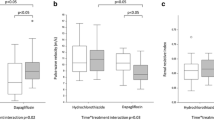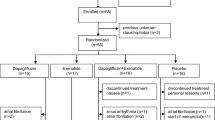Summary
The effect of the calcium antagonist nicardipine on insulin secretion and glucose homoeostasis was investigated in elderly hypertensives with and without diabetes mellitus; 15 patients with essential hypertension for at least 10 years and normal glucose tolerance according to standard criteria (Group I) and 15 elderly hypertensive patients affected by Type 2 diabetes mellitus and on treatment with diet or oral drugs (Group 2).
In the basal state, all patients were submitted to an oral glucose tolerance test (OGTT, 75 g) and an iv arginine test (30 g), on two different days and in random order. The same tests were repeated after one month of treatment with nicardipine 60 mg/day, in three spaced doses, the last being given 1 h before the post-treatment test. Nicardipine did not change overall glucose homoestasis, as assessed by haemoglobin Alc and fructosamine, nor did it significantly affect the plasma insulin response either to glucose or arginine in Groups 1 and 2. Only the glucagon response to arginine was significantly reduced in diabetic hypertensives. Small, non-significant variations in the metabolic and hormonal parameters were seen in additional two groups of patients (Groups 3 and 4), matched with Groups 1 and 2 for age, sex and diseases, who took capsules containing placebo.
Thus, nicardipine did not produce any significant over-all alteration in glucose homoestasis when given to elderly diabetic or nondiabetic hypertensive subjects.
Similar content being viewed by others
References
Bo Hellman (1986) Calcium transport in pancreatic beta-cells: implications for glucose regulation of insulin release. Diabetes/Metabolism Rev 2:215–242
Leclereq-Meyer V, Marchand J, Malaisse WJ (1978) The role of calcium in glucagon release: studies with verapamil. Diabetes 27: 996–1004
Manery JF (1966) Effects of calcium ions on membranes. Fed Proc 25:1804–10
Kneer NM, Wagner MJ, Lardy HA (1979) Regulation by calcium of hormonal effects on gluconeogenesis. J Biol Chem 254: 12160–12168
Devis G, Somers G, Van Obberghen E, Malaisse WJ (1975) Calcium antagonists and islets function. I. Inhibition by verapamil. Diabetes 24: 547–551
Malaisse WJ, Sener A (1981) Calcium antagonists and islet tunction. XII. Comparison between nifedipine and chemically related drugs. Biochem Pharmacol 30: 1039–1041
Kimura S, Matsumoto T, Tada R, Ogata E, Abe K (1982) Inhibition by calcium channel blockers of the glycogenolytic effect of glucagon in perfused rat liver. Acta Endocrinol 99: 559–566
Trost BN, Weidmann P (1987) Effects of calcium antagonists on glucose homeostasis and serum lipids in non-diabetic and diabetic subjects: A review. J Hypertens 5 [Suppl 4]: S81-S104
Smith CP, Tarn AR, Thomas JM, Overkamp D, Corakci A, Savage MO, Gale EAM (1988) Between and within subject variation of the first phase insulin response to intravenous glucose. Diabetologia 31: 123–125
Natali A, Santoro D, Palombo C, Ghione S, Ferrannini (1990) Diabetes and high blood pressure. Diab Nutr Metab 3: 67–84
National Diabetes Data Group (1979) Classification and diagnosis of diabetes mellitus and other categories of glucose intolerance. Diabetes 28: 1039–1057
Torella R, Salvatore T, Spiezia R, Di Pinto P, Giunta R, Grandillo F (1986) Is the common presence of glucose intolerance in old age a reliable index for the subsequent occurrence of fasting hyperglycemia? Acta diabetol Lat 23: 57–63
Giugliano D, Salvatore T, Cozzolino D, Ceriello A, Torella R, D'Onofrio F (1987) Sensitivity to beta-endorphin as a cause of human obesity. Metabolism 36: 974–978
Santiago JV, Davis JE, Fisher F (1978) Hemoglobin Alc levels in diabetes detection program. J Clin Endocrinol Metab 47: 578–593
Baker JR, O'Connor JP, Metcalf P, Lawson MR, Johnson RN (1983) Clinical usefulness of estimation of serum fructosamine concentration as a screening test for diabetes mellitus. Br Med J 287: 863–867
Giugliano D, Gentile S, Verza M, Passariello N, Giannetti G, Varricchio M (1981) Modulation by verapamil of insulin and glucagon secretion in man. Acta Diabetol Lat 18: 163–171
Simonson DC (1990) Etiology and prevalence of hypertension in diabetic patients. Horm Metabol Res 22 [Suppl]: 1–8
Pyörälä K, Laasko M, Uusitupa M (1987) Diabetes and atherosclerosis: an epidemiologic view. Diabetes/Metabolism Rev 3: 463–524
Jarrett RJ, McCarthy P, Keen H (1982) The Bedford Survey: tenyear mortality rates in newly diagnosed diabetics, borderline diabetics and normoglycemic controls and risk indices from coronary heart disease in borderline diabetics. Diabetologia 22: 79–84
Giugliano D, Torella R, Cacciapuoti F, Gentile S, Verza M, Varricchio M (1980) Impairment of insulin secretion in man by nifedipine. Eur J Clin Pharmacol 18: 395–398
Trost BN (1990) Glucose metabolism and calcium antagonists. Horm Metabol Res 22 [Suppl]: 48–56
Kannel WB, McGee DL (1979) Diabetes and cardiovascular risk factor: the Framingham Study. Circulation 59: 8–13
Rose GA (1985) Hypertension in the community. In: Bulpitt CJ (ed) Handbook of hypertension, epidemiology of hypertension, vol 6. Elsevier, Amsterdam, pp 1–14
O'Hare JP (1920) Glucose tolerance test in chronic vascular hypertension. Am J Med Sci 160: 366–369
Verza M, D'Avino M, Cacciapuoti F, Aceto E, D'Errico S, Varricchio M, Giugliano D (1988) Hypertension in the elderly is associated with impaired glucose tolerance independently of obesity and glucose intolerance. J Hypertens 6 [Suppl]: S45-S48
Reaven GM (1988) Role of insulin resistance in human disease. Diabetes 37: 1595–1607
Cody RJ, Kubo SH, Ryman KS, Shaknovich A, Laragh JH (1986) The acute antihypertensive effects of nicardipine: haemodynamic characteristics. J Hypertens 4 [Suppl 5]: 5443–445
Author information
Authors and Affiliations
Rights and permissions
About this article
Cite this article
Giugliano, D., Saccomanno, F., Paolisso, G. et al. Nicardipine does not cause deterioration of glucose homoeostasis in man: A placebo controlled study in elderly hypertensives with and without diabetes mellitus. Eur J Clin Pharmacol 43, 39–45 (1992). https://doi.org/10.1007/BF02280752
Received:
Accepted:
Issue Date:
DOI: https://doi.org/10.1007/BF02280752




